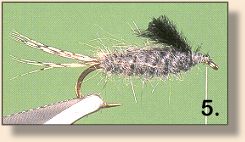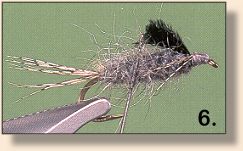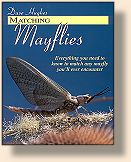Gray Swimmer Nymph
By Dave Hughes
Photos by Jim Schollmeyer
Swimmers [nymphs] are best adapted to lakes and ponds, and to the
peaceful flows of spring creeks and tailwaters. Some are found
in the faster water of freestone streams, but usually along the
edges or on flats with less than swift currents. Some species
have adapted to riffles and runs, but swimmers are most important
to anglers where the water is either still, or slow and stable
enough to allow the growth of rooted vegetation.
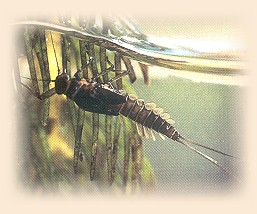
In stillwaters, swimmer nymphs are most abundant in vegetated
shallows, but can be found wherever weeds grow. Swimmers are
the most important mayfly nymphs in lakes and ponds. In moving
water they'll be most abundant, and therefore most important,
in slow water with weed growth trailing in the currents. You'll
not often encounter need for swimmer nymph imitations in fast streams.
Natural nymphs must blend with the backgrounds on which they live
or they'd not survive to pass on their genes to any next generation.
They will always be found in subdued colors, usually shades of olive,
brown, or gray. It's wise to collect specimens of nymphs - swimmers and
all other types - in waters that you fish constantly, and match their
colors precisely. But fly boxes that contain swimmer nymph styles
that cover those three most common colors, tied on hooks from tiny
size 22 up to 12, will almost always hold a killing fly at the start.
You'll need to tie or buy further flies only for rare deviations.
Materials: Gray Swimmer Nymph
Hook: 2x or 3x long, size 10 to 14.
Weight: 15 to 20 turns lead wire, optional.
Thread Gray 6/0 or 8/0.
Tails: Gray partridge.
Body: Muskrat fur or fur/Antron mix; as noodle.
Wingcase: Black ostrich fibers.
Legs: Gray partridge.
Tying Steps:
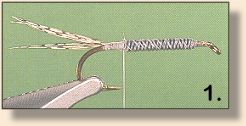
1. Layer the hook with lead wire one size finer than the shank diamenter,
or omit weight. I recommend you try some weighted, some unweighted, to
see which work best for you. Layer the hook shank with thread. Secure
six to ten partridge fibers, measure them two-thirds the length of the
hook shank, and tie them in at the bend.
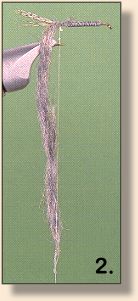
2. This is a variation of the late Polly Rosborough's Black Drake.
Polly clipped muskrat fur from the skin, removed the guard hairs,
teased and then rolled the fur into a two- to three-inch noodle.
I prefer a mix of fur and Antron, for a bit of sparkle. Roll
the noodle and tie its end in at the base of the tail. Coat your
thread with sticky dubbing wax or head cement, so the noodle
sticks to it.
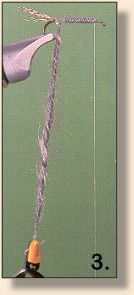 3. Take the thread over your off-hand finger tip, and return
it to the hook shank, to make a thread loop the length of the
noodle. Use your thumb and forefinger tip to twist the thread
loop and the tip of the noodle together, to form a tight and
slightly tapered dubbing skein. Catch the end of the skein with
your hackle pliers.
3. Take the thread over your off-hand finger tip, and return
it to the hook shank, to make a thread loop the length of the
noodle. Use your thumb and forefinger tip to twist the thread
loop and the tip of the noodle together, to form a tight and
slightly tapered dubbing skein. Catch the end of the skein with
your hackle pliers.
|

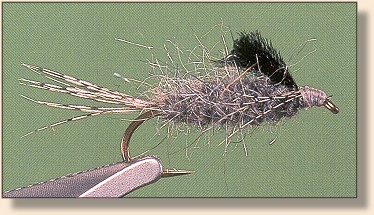
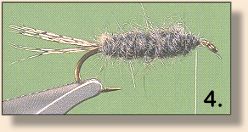



 3. Take the thread over your off-hand finger tip, and return
it to the hook shank, to make a thread loop the length of the
noodle. Use your thumb and forefinger tip to twist the thread
loop and the tip of the noodle together, to form a tight and
slightly tapered dubbing skein. Catch the end of the skein with
your hackle pliers.
3. Take the thread over your off-hand finger tip, and return
it to the hook shank, to make a thread loop the length of the
noodle. Use your thumb and forefinger tip to twist the thread
loop and the tip of the noodle together, to form a tight and
slightly tapered dubbing skein. Catch the end of the skein with
your hackle pliers.